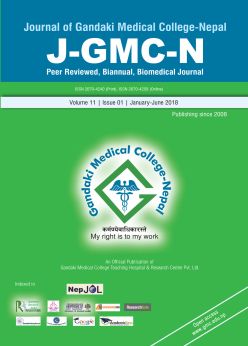Epidemiology and Clinical Outcome of Snakebite in Western Nepal: A Retrospective Study
DOI:
https://doi.org/10.3126/jgmcn.v12i1.22618Keywords:
Case fatality rate, Poisoning, Snake biteAbstract
Introduction: Snakebite is an environmental hazard associated with significant morbidity and mortality. It is an important medical emergency and cause of significant numbers of hospital admissions in many parts of the Asian region. In this study, we assess the epidemiology and clinical outcome of snake bite.
Methods: This was a retrospective study of all patients with snake bites admitted to the Department of Internal Medicine, Manipal Teaching Hospital, Pokhara, kaski, Nepal. A total numbers of 265 snake bite cases in the period of 2013 to 2016 were enrolled in this study. Snake bite cases by person, place and time along with month of snake bite and time of bite, were analyzed. We also identified the types of snake and site of the bite. Sign and symptoms were clinically observed and the management of the snake bite cases was clinically done. Prothrombin time (PT) test along with INR value was performed by Medical Technologist at the Department of Laboratory, Manipal Teaching Hospital. Data was entered in to the Microsoft excel and analyzed by SPPS version 21.0. Percentages were applied to find the results.
Results: Total numbers of snake bite cases were 265. More than half, 60.4% of the snake bite cases were females. Regarding the age group, nearly half, 47.9% were in the age group of 20 - 40 years and 9.8% cases were in the age group of 60 years and above. In this study, 50.6% bite cases were held at the day time and most of the bites were reported/ observed in the limb, 53.6% in lower limb, and 43.4% in the upper limb. Very few bites were in the head, neck and trunk. Our result shows 49.1% were green snake and 30.9% snake were unidentified. When we observed the sign and symptoms, 153 (57.7%) cases showed local swelling, 83 (31.3%) showed fang mark. Hematological manifestation were 144 (54.3%) cases and complication observed in 145 (54.7%) cases. Snake bite cases were managed after PT/INR test, INR. Antibiotic were prescribed in 154 cases and in 135 (50.9%) cases blood was transfused. There were no fetal cases noticed among hospital admitted snake bite cases.
Conclusion: There is gross disparity in the management and outcomes of snake bite in different hospitals. Snake bite cases should manage in tertiary care hospital as early as possible.
Downloads
Downloads
Published
How to Cite
Issue
Section
License
This license allows reusers to distribute, remix, adapt, and build upon the material in any medium or format for noncommercial purposes only, and only so long as attribution is given to the creator.




